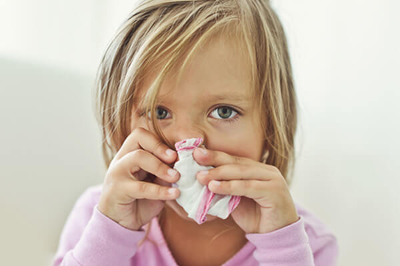
Allergies
Seasonal allergy symptoms usually occur early summer and include sneezing, congestion, a stuffy or runny nose, throat irritation, and watery eyes.

Asthma
It is important to monitor your child’s breathing during this time and if they have asthma, make sure it is well controlled.

Colds and upper respiratory
Among the many viruses we see causing respiratory illness right now, the influenza virus (commonly called “the flu”) can be particularly severe. Infection with the influenza virus causes sudden onset of a fever, chills, dry cough, and muscle aches. Other symptoms include headache, fatigue, sore throat, and nasal congestion.
Some children are at increased risk of more serious illness from influenza, because of conditions such as diabetes, asthma, immunity problems, or being treated with immune-suppressing medications. They are especially vulnerable to complications, and should get vaccinated as soon as possible. The “Seasonal Flu Shot” that has been administered to many people this year protects against Influenza A and B.
Please get a vaccination if you and your child have not yet had it this year!
To learn more about the flu and see the most up to date information, go to: https://www.cdc.gov/flu/about/season/current.htm
There have been flare-ups of asthma due to respiratory inflections. It is important to monitor your child’s breathing during this time and if they have asthma, make sure it is well controlled.
If you notice your children having difficulty breathing, scheduling an asthma consult is recommended. If your child has had asthma consult before, but it was longer than 6 months ago and your child is having difficulty breathing, we suggest scheduling another consult.
With the change of seasons, we are seeing an increase in patients with seasonal allergies. Seasonal allergy symptoms usually occur between February and early summer and include sneezing, congestion, a stuffy or runny nose, throat irritation, and watery eyes. In some cases, seasonal allergies can also cause itchiness, puffy eyes, coughing, fatigue, and headaches. To reduce symptoms, minimize your exposure to allergy triggers by staying indoors on dry, windy days and monitoring the outdoor pollen count through the internet or local newspaper, being sure to avoid outdoor activity on mornings with a high pollen count. There are also over-the-counter medications that can be taken to reduce seasonal allergy symptoms.
Source: mayoclinic.org
We are currently seeing cases of bronchiolitis, a viral illness (sometimes caused by RSV — “respiratory syncytial virus”) that occurs most often in children under age 2. This virus typically occurs in epidemics during the winter and the early spring. “Bronchioles” are the smallest airways in our lungs, and “itis” means these airways are inflamed, or irritated, by the virus. When these airways get inflamed in young children, they often will start to “wheeze,” meaning air and the oxygen in it have difficulty getting through these narrowed, swollen airways.
With a case of bronchiolitis, your infant’s symptoms may begin with a runny nose, a fever, and a harsh, tight cough. If it progresses to wheezing, your child may start to breathe rapidly and “pull” with his/her abdomen and rib muscles with each breath. Please call us for an appointment if your child’s breathing becomes labored or difficult.
If your infant was born premature (under 32 weeks) or has cardiac or lung conditions, and your child is younger than 2 years of age, your child is at a greater risk of complications from RSV bronchiolitis. A product containing a specific antibody to RSV has been approved for monthly administration to help prevent RSV infection in these high-risk children. This form of antibody against RSV has the advantage of being able to be administered once a month by intramuscular injection. In large, controlled studies, this product has been shown to decrease hospitalization from RSV infections in these high-risk infants.
Colds, upper respiratory infections, and URIs are common terms we use to describe viral illnesses that cause nasal congestion, runny nose, sneezing, sore throat, fever, and cough. The fever usually lasts for 2-3 days, and the cough with congestion and runny nose may last for 5-10 days. The typical preschool-age child may experience 6-10 colds per year. Most colds resolve on their own with rest and fluids, but some may lead to ear infection, sinus infection, asthma attack, or other complications. If you are concerned about the possibility of one of these complications, please have your child seen in our office for an evaluation.
We are currently seeing children and adolescents come into our office with a cough, typically one of the most prominent and bothersome symptoms of viral respiratory infections. Coughing is an important and beneficial reflex that our bodies need to clear secretions and to keep open our major airways during the course of a viral cold or upper respiratory infection. However, severe or persistent cough can be associated with asthma, pneumonia, sinus infections, and bronchiolitis, and should be evaluated by your health care provider.
We are currently seeing cases of croup, a viral respiratory illness that most often is caused by the parainfluenza virus. The cough and breathing that are associated with croup make it distinctly different from other viral colds or respiratory illnesses. This is because the parainfluenza virus infects and irritates the voice box, the vocal cords, and the windpipe. The cough is worse at night, and it has a distinct bark that sounds much like a seal’s bark. Associated with the barky cough, your child may have difficulty when inhaling air, making a labored and whistling sound when breathing in — called stridor. Humidified air and fluids often are the most helpful treatments. Please call the office to have your child evaluated by the doctor if he/she has symptoms of croup.
Among the many viruses we see causing respiratory illness right now, the influenza virus (commonly called “the flu”) can be particularly severe. Infection with the influenza virus causes sudden onset of a fever, chills, dry cough, and muscle aches. Other symptoms include headache, fatigue, sore throat, and nasal congestion.
Some children are at increased risk of more serious illness from influenza, because of conditions such as diabetes, asthma, immunity problems, or being treated with immune-suppressing medications. They are especially vulnerable to complications, and should get vaccinated as soon as possible. The “Seasonal Flu Shot” that has been administered to many people this year protects against Influenza A, B and H1N1.
Please get a vaccination if you and your child have not yet had it this year!
We are currently seeing an increase in cases of Pertussis in our community. Pertussis, or whooping cough, is a respiratory illness that begins with mild cold symptoms and progresses to a severe cough. The cough comes in spasms and is sometimes characterized by a high-pitched whooping sound followed by vomiting. Classic pertussis lasts several weeks with some cases lasting 10 weeks or longer. Pertussis is most severe when it occurs in the first 6 months of life, particularly in those who are unimmunized or who are born prematurely. Older siblings and adults with mild symptoms are an important reservoir of infection for young children and infants. Pertussis is diagnosed clinically and confirmed with laboratory tests.
Treatment
While antibiotics have minimal effect on the course of the illness once the classic whooping cough has begun, they are recommended to limit the spread of the illness. Confirmation of the illness by a medical provider helps guard against the overuse of antibiotics in the setting of a viral illness and subsequent development of organisms that are resistant to antibiotics. Control measures: All household contacts of young infants should receive a pertussis vaccine booster. Others who are unimmunized or under-immunized should complete the recommended schedule of immunizations (see our website for the recommended vaccination schedule). Household contacts and other close contacts of those who have been diagnosed with pertussis should receive prophylactic antibiotic treatment to prevent transmission of the disease. Students and school staff with a confirmed diagnosis of pertussis should be excused from school until they have completed a five day course of antibiotic therapy.
We are currently seeing quite a bit of strep throat. If your child has a fever, sore throat, headache, or stomachache without any other viral symptoms like congestion or cough, it may be strep throat. Bacteria, called Group A strep, cause this type of sore throat. To diagnose strep throat your physician will require a swab of your child’s throat, and antibiotics will be needed if the strep test is positive.
We are currently seeing children and adolescents with viral upper respiratory infections: severe nasal congestion and secretions, sore throat, occasional vomiting and fever for 2-3 days. These symptoms are followed by a dry, persistent cough that may last for 5-10 days.
Gastroenteritis is a common childhood illness that causes diarrhea and vomiting that can lead to dehydration. It is usually caused by a virus but can also be caused by bacteria or a parasite. Most of the time mild diarrhea and vomiting last for just a few days. However, if symptoms don’t go away or they get worse, your child may need to be treated in the hospital.
Symptoms to watch for
Call your child’s doctor if your child is younger than 6 months and has any of the following:
-
Blood in the stool
-
Frequent vomiting
-
Stomach pain
-
Urinates less often (Wets fewer than 6 diapers per day.)
-
No tears when crying
-
Loss of appetite for liquids
-
High fever (over 102°F or 39°C)
-
Frequent diarrhea
-
Dry, sticky mouth
-
Weight loss
-
Extreme thirst
Care for yourchild at the hospital
The biggest concern with gastroenteritis is dehydration, which occurs when a child loses too much fluid and becomes dried out. If your child has lost a lot of fluids from vomiting or diarrhea, he may need an IV to get fluids back into his body. An IV is a small plastic tube that is placed inside a vein under your child’s skin. Fluids are given through the IV.
When can my child go home?
Once your child gets fluids into her body and starts making normal amounts of urine again, she will be able to go home. This can take only a few hours, or your child may need to stay overnight in the hospital.
Care for your child at home
For cases of mild to moderate diarrhea, continue to give your child a normal diet including formula or milk. Breastfeeding can continue. If your child is not able to tolerate cow’s milk because of the diarrhea, talk with your child’s doctor about temporarily removing it from his diet.
Special fluids calledelectrolyte solutionshave been designed to replace water and salts lost during diarrhea. Do not try to prepare these special fluids yourself. Ask your child’s doctor or a pharmacist for a recommendation.
Continue to feed your child if they are not vomiting. You may have to give your child smaller amounts of food than normal or give your child foods that do not further upset his stomach.
We are currently seeing viral illnesses that cause vomiting and diarrhea. Usually called viral gastroenteritis, the virus causes inflammation and irritation of the stomach and the intestines, leading to vomiting and diarrhea. This illness, often called the “stomach flu”, typically lasts 1-2 days, with diarrhea lasting a few days longer.
It is important to make sure that your child does not get dehydrated with this condition. Offer Gatorade or Pedialyte in small amounts every 20 minutes until your child can keep liquids down. If they are unable to keep liquids down, back off for 2 hours, then try the small amounts again. If your child has few wet diapers and does not make tears, or appears limp or lethargic, they may be dehydrated and we will need to see them in our office.
